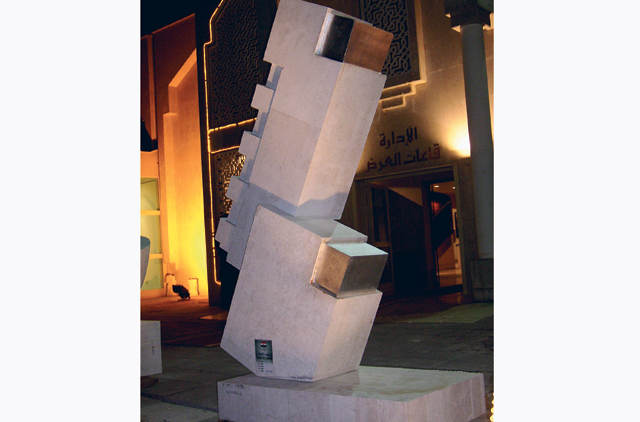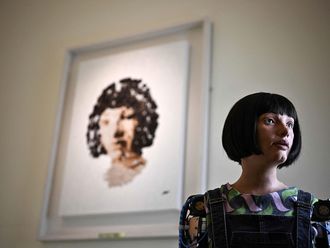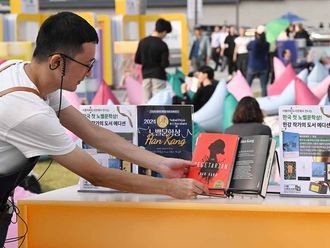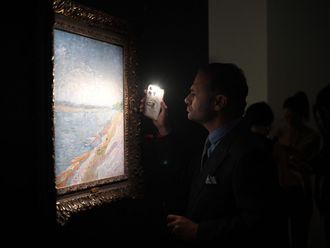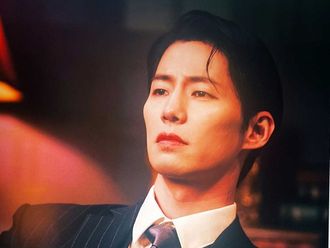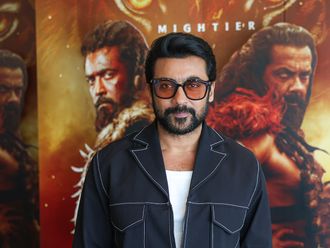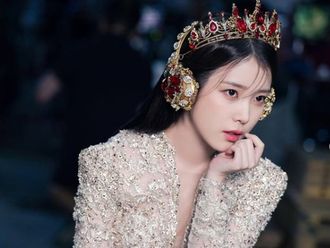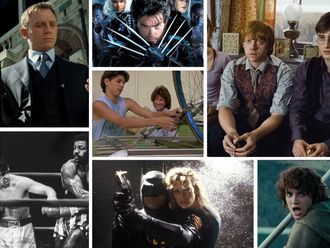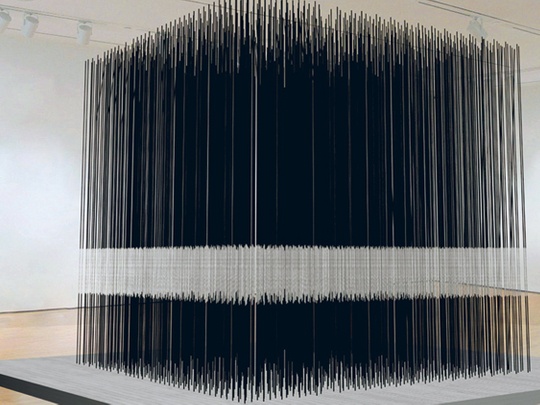
Art is for everybody, not only for connoisseurs," Salwa Zeidan says, when asked what motivated her to bring an international sculpture symposium to Abu Dhabi.
Salwa started off with a mission: to make art accessible to the public and develop the local contemporary art scene. Being the artistic director of the ongoing Abu Dhabi International Sculpture Symposium, she is firm on the heels of her intents. The much-anticipated milestone event brings together 17 contemporary sculptors, who create works live for the public.
The artists participating in the inaugural run are: Billy Lee from the United Kingdom, Caroline Ramersdorfer from Austria, Ehab El Laban from Egypt, Fabrizio Dieci from Italy, Gheorghi Filin and Petre Petrov from Bulgaria, Gregor Kregar from Slovenia, Hassan Sharif from the United Arab Emirates, Hwang Seoung-Woo from Korea, Jo Kley from Germany, Jon Barlow Hudson from the United States, John Gogaberishvili from the Republic of Georgia, Konstantin Dimopoulos from Australia, Masahiro Hasegawa and Yoshin Ogata from Japan, Hussam Chaya from Lebanon and Juanjo Novella from Spain.
"We received 400 applications, ranging from abstract ideas to semi-realistic designs, mainly aimed at complementing the history and culture of Abu Dhabi," Salwa says. "Each artist has been carefully selected to give the symposium a multicultural context with an alignment to its theme: Bridging societies through the language of art."
Weekend Review talked to some of the artists about the inspiration and insight behind their sculptures.
Caroline Ramersdorfer analyses, carves and repositions fragments from blocks of stone or slabs of marble.
These fragments combine with the resulting layers to create complex, translucent interior spaces that capture and reflect light at a certain depth.
Gogaberishvili moulds new margins in the interior of the object to unify space and light. The dynamic form permeates an illusion of vitality and fuses the body and spirit to deliver an impression that is stylistic and technological in concept. "I want to create art that will last no matter the time," Gogaberishvili says.
For Lee art is a way of life and so his maquettes are alliterative markers of human expressions. The touch of simplicity is readily felt in his monumental masterpieces such as EOS and Kiss. Lee's sculptures are rooted in a Post-Modernist notion coming from the constructivist and minimalist tradition with a contemporary twist. The occult subtlety and apparent rigidity of the materials such as granite, stone, steel and bronze perfectly impart what seems to be missed in otherwise two-dimensional images.
Seoung-Woo's huge pile of accumulated papers embodies the material world in a piece of stone. "Papers serve as a kind of ‘hidden power' bearing the language that we use," Seoung-Woo says.
But whether we view it as a stack of books representing accrued cross-cultural knowledge, or as a commentary on the permanence of our society's ecological decisions, the work of art expresses his inner world, his surroundings and concerns. "I feel the cycle of life in the process of making sculptures," he says. "I understand the world with its layers." Different topics related to human affairs and nature are materialised in a visual shape.
Lines, colour, repetition and movement are integral to the distinctive sculptures of Australian artist Dimopoulos. In 2001, he created Pacific Grass — the first wind sculpture commissioned by the Wellington Sculpture Trust and given to the City of Wellington. It became a well-loved icon among both locals and visitors to the windy city.
His public installations focus on issues relating to the very existence of us as a species. For example, Blue Trees highlights the importance of trees for the planet's survival and will be featured in the 2010 Vancouver Biennale. Black Parthenon is a public light installation highlighting the issue of repatriation of cultural and religious objects to their rightful countries. The work also addresses issues of cultural appropriation and repatriation globally that we need to address as a society.
Filin is often described as "a sculptor of liberated forms". Liquids appeal to Filin the most, as they best interpret the concept of universal development. It also ignites the motif of the "waves" in his monumental sculptures.
"I research, create and internalise what mother earth is," says Filin. "The process is always ethical and without any subterfuge." The contrasts of light and shadow, strength and lightness, shape and balance and water and wind reflect the constant challenge that the sculptor engages in marble. "The light penetrates deeper to play with the forms by changing the silhouette image and emotions in marble."
Novella is an award-winning artist who has been working for public spaces for about 27 years as a specialist in urban interventions. He employs a unidirectional approach, interpreting time, following the dictates of a place and questioning the "soul" of space and sometimes altering the hierarchy of cognition. "Public art is essential for a healthy society," Novella says. "Public art serves the spiritual and metaphysical necessities of man."
Hasegawa usually executes a unique subject matter. He sculpts the lotus in hand-brushed steel and decked with raindrops made of glass or resin. "The lotus is very common in Japan. Almost all Japanese love [the flower]. It gives us a comfortable feeling," Hasegawa says.
The concavity of a stream is the trademark of fellow-Janpanese Ogata's art. The artist chisels the ripples and curves in stone, metal and wood. "I try to express vividly a story of two confronting concepts: nature and abstraction," Ogata says.
Kregar: Examination of architecture is one of the most essential parts of Kregar's sculptural practice and we notice this in his more recent sculptures such as Twisting the Void and Piercing the Clouds. Kregar uses mirror polished stainless steel that reflects the environment the sculptures inhabit and echoes invisible molecular structures.
"I have a strong interest in mathematics and chemistry, especially in the Platonic and Archimedean solids and the way they were used by Buckminster Fuller and other avant-garde architects," he says.
Hudson is particularly sensitive to designing for compatibility within the architectural context and environmental ambience. The themes vary accordingly. For example, his previous series of work was inspired by the ancient Chinese jade ritual object, cong or ts'ung tube. "The artefact represented the unity of paradise and earth through the squares and the circle," Hudson says.
Hudson works with stone. The latest series of stone sculptures represents a votive figurine of a slender maiden without head or arms. For the symposium in Abu Dhabi, the artist intends to utilise the Sufi concept of the "hidden" and "manifestation".
"You can compare it with the Yin and Yang of East Asia, which is spiritual and materialistic. The metal is the material form, which manifests the empty space and that space is hidden with a spirit in the centre," Hudson explains.
Sharif: A pioneer in awakening the UAE to contemporary arts, Sharif criticises the growing consumerism in present-day society. The sarcastic outlook on life is a result of his engagement in social and political caricatures for different publications.
In addition, he also witnessed the 1970s artistic theories of art in Europe and America that criticised a life that revolved around consumption in all forms and the slew of negative effects it brought on an individual's thinking.
"The new world order, whose slogan is ‘adapt your aspirations to our ends — or else', particularly irritated me," Sharif says. "This vulgar market mentality that flooded shops with consumer products had so infiltrated the minds of individuals that it now controlled them as slaves to greedy corporate tycoons."
Sharif also draws and paints using different subjects and multiple styles. He works with an aim: to show society its own auto-phage and alert it about the actions of social subjects, who produce and generate materials of all kinds in ever-increasing and unconditional scale.
Each intervention and action applied to the objects translates itself into emotional participation that reverberates on to it and leads the viewer to authentic and intimate comprehension.
"I call this process ‘making objects'," Sharif says. "I resorted to the idea of ‘redundant repetition' in producing it. I would continually engage myself in boring, recurring and endless activities, a feature that would become a signature of my artwork since 1982."
Under the patronage of Shaikh Mohammad Bin Zayed Al Nahyan, Crown Prince of Abu Dhabi and Deputy Supreme Commander of the UAE Armed Forces, the six-week symposium is organised by Zayed University in collaboration with the Salwa Zeidan Art Gallery.
Strategic partners for this event are the Municipality of Abu Dhabi City and the Armed Forces Officers Club.
At the conclusion of the symposium, the sculptures will be permanently placed at selected public spaces throughout Abu Dhabi, which will complement Shaikh Mohammad Bin Zayed's vision for a cultural city with artistic landmarks.
Layla Haroon is a freelance writer based in Abu Dhabi.
The Abu Dhabi International Sculpture Symposium is on at the Armed Forces Officers Club until April 7. Visiting hours are 5 to 7pm, Saturday to Thursday. Entry is free.
For public lecture programmes and the workshops please visit www.adiss-ae.com


